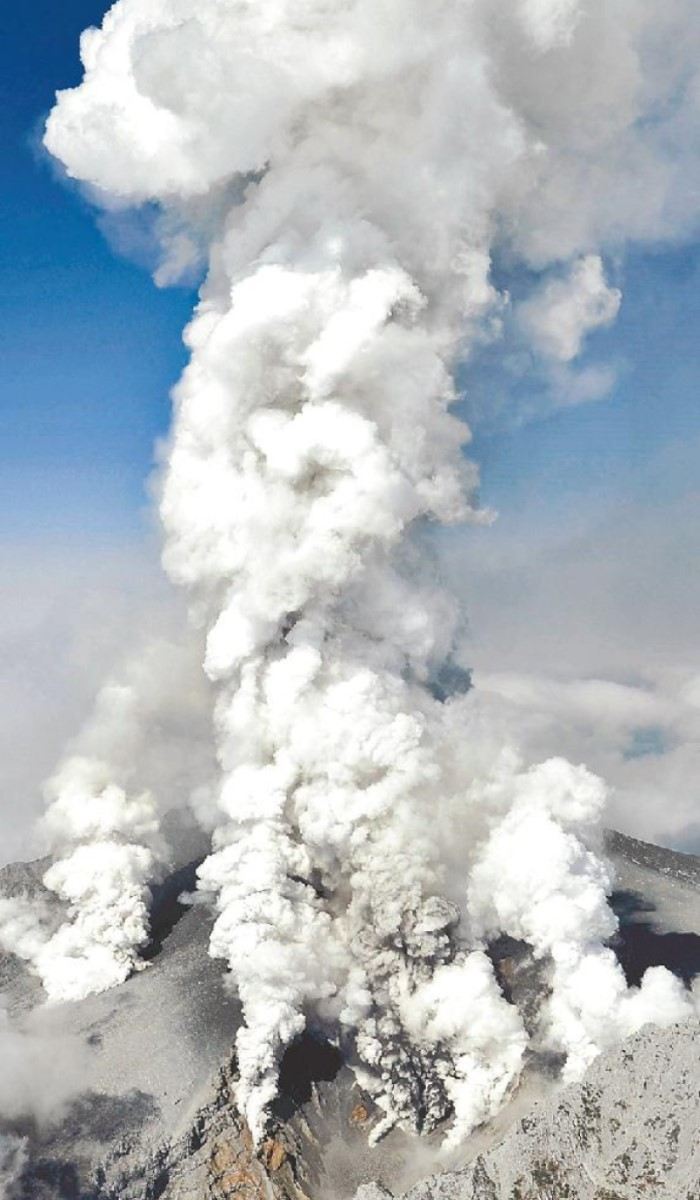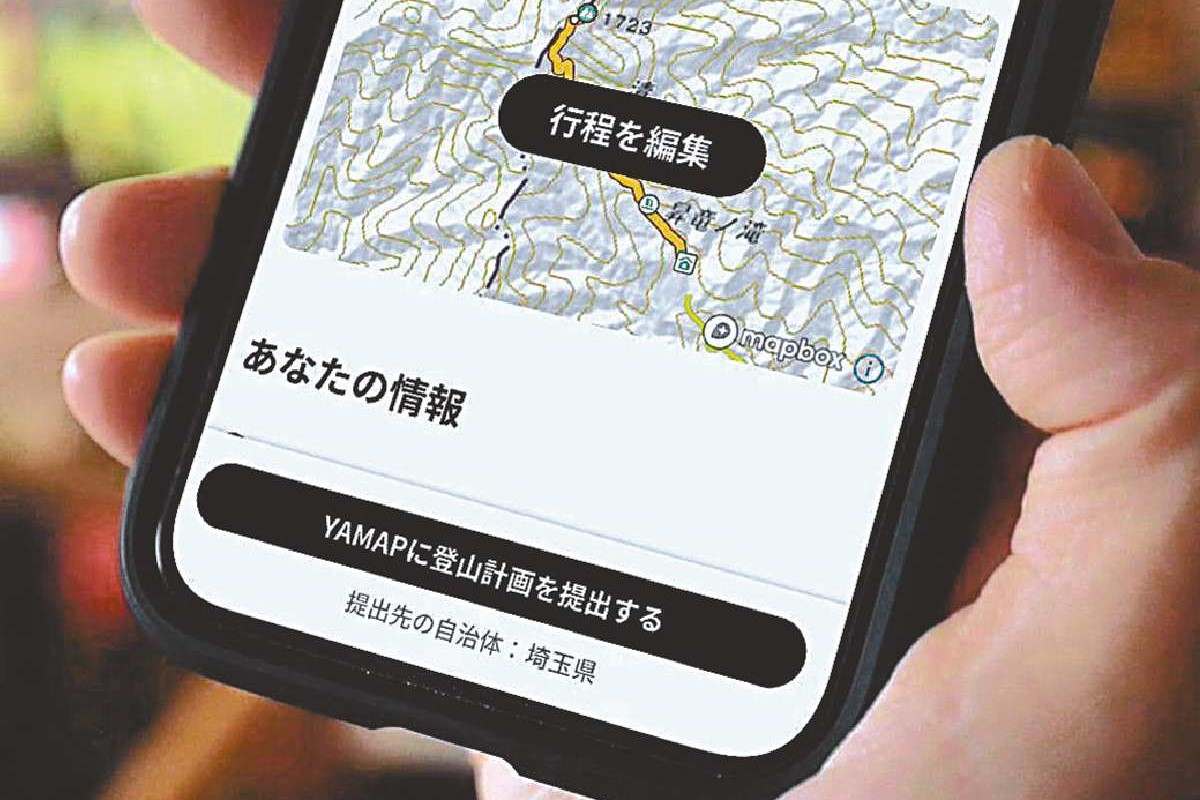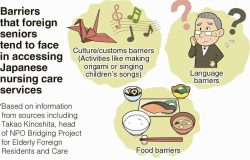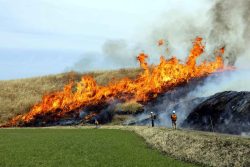
An aerial photo of the Mt. Ontake eruption in September 2014
12:28 JST, November 13, 2023
The Autumn foliage is near its peak, luring climbers to the colorful mountains. But they should always be prepared for the unexpected — especially when hiking on a volcano.
If an eruption were to suddenly occur, volcanic rocks, ash and other material ejected from the volcano could endanger the lives of hikers. It is vital to plan ahead and take precautions, such as collecting information like volcanic disaster prevention maps and confirming the expected scale of damage in an eruption. Hikers can also search for the locations of evacuation sites or other places where they can take shelter. Such precautions will help hikers know what to do in the event of an eruption and stay safe.
Let’s consider what actions to take in a hypothetical scenario.
***
Setting off in high spirits and lightly equipped
Taro, a 45-year-old company employee from the Tokyo metropolitan area, enjoys hiking in the mountains. One weekend, he set out by himself to climb an active volcano in the Koshinetsu region that is popular with climbers.
Taro had never hiked on that mountain before. Before starting his climb, to be on the safe side he checked the Japan Meteorological Agency website, which displays the alert levels for volcanoes across the nation. The mountain he planned to climb was categorized as Level 1 — the lowest alert level.
“Nothing much to worry about,” Taro thought to himself. Under clear blue skies, Taro set off in high spirits and lightly equipped. He did not even bother checking for details such as evacuation shelter locations near the hiking trail.
Taro’s ascent to an area near the volcano’s crater proceeded smoothly. He sat down on a rock and soaked in the magnificent view.
A sudden explosion — and screams
When Taro casually looked more closely at the crater, he saw that smoke was increasingly rising into the air. The smoke turned blackish and a strange smell filled his nostrils.
“I wonder if the volcano will erupt,” Taro thought to himself. Feeling uneasy, he quickly decided to descend the mountain. Just then, a large explosion suddenly filled the air. Taro fearfully turned around and saw massive plumes of volcanic smoke pouring from the crater and down the side of the mountain.
Taro knew his life would be in danger if he was struck by the rocks that came shooting out of the volcano at tremendous speed. Images of previous eruption disasters flashed through his mind. Taro’s only option was to hurriedly cover his head with his backpack and crouch down to take cover behind a nearby rock.
He heard screams ring out from here and there.
Finding a safe place
After a while, Taro sensed that the volcanic smoke had eased up slightly. Another person who had been taking shelter nearby warned that the eruption might have a second wave of activity. “Let’s go down while we can,” suggested another.
Taro walked down the mountain to a safe spot. After regaining his composure, he was contacted by Jiro, a 45-year-old colleague that Taro had earlier told about his hiking plans. “Were you injured?” Jiro asked as he checked on Taro’s safety.
According to news reports he saw later, several hikers got caught up in the eruption and remained unaccounted for. “Perhaps I just had luck on my side,” Taro said to himself.
The events of that day reminded Taro just how frightening climbing an active volcano could be.

A shelter on Mt. Ontake
Don’t let your guard down
Japan is a volcanic country with 111 active volcanoes, many of which are popular for climbing.
The Japan Meteorological Agency currently monitors the status of 50 volcanoes, and with the exception of Iwoto Island, categorizes them into five Volcanic Alert Levels. The agency’s website provides suggestions to climbers on what they should do depending on the level. Most volcanoes are set at Level 1, the lowest status.
“Before climbing mountains, please check the alert level and the latest activity status,” said Rintaro Kamata, an official of the volcanic disaster prevention office in the agency’s volcano monitoring department.
Climbing should be avoided if an alert is Level 2 or higher, or if the area is hit by regular earthquakes.
Check how damage could spread
“Don’t let your guard down even if the alert level is 1,” said Kim Heangyoong, a designated lecturer at Nagoya University’s Ontakesan Volcano Laboratory. “Eruptions can occur without warning.”
Mt. Ontake, on the border between Nagano and Gifu prefectures, was at the “normal” Level 1 status when an eruption occurred in September 2014. Ash deposits and volcanic dust hit climbers near the summit, leaving 63 people dead or missing. Since the incident, efforts have been made across the country to strengthen monitoring systems by installing more devices to observe active volcanoes. Shelters and evacuation huts located near the summit have been built or renovated.
Climbers are urged to check how danger could spread in the event of an eruption, and should confirm the location of evacuation routes and emergency shelters. This information is detailed on disaster prevention maps provided by local governments.
A climbing registration form, which can assist in rapid response and identification, should be submitted to police or relevant authorities. Fukuoka Prefecture-based Yamap Inc., operator of the Yamap mountaineering app, has signed agreements with 16 prefectures which allows users to submit the form via their smartphone. Climbers are urged to regularly check information on eruptions through disaster management apps or other means.

The Yamap mountaineering app
Protective gear is a must
Protective gear is also essential. Be sure to bring a helmet to protect your head from falling ash, as well as goggles and masks to protect against volcanic dust.
“Rising fumes, funny smells and earth sounds may be warning signs,” said Shuichi Kaneko, a mountaineer and former rescue team head of the Tokyo Mountaineering Federation. “If you notice anything unusual while climbing, move away from the crater immediately and descend.”
It is dangerous to approach a crater that is emitting smoke, or to keep taking photographs of the scene.
An eruption can cause deposits to scatter in all directions for several kilometers from the crater, and a direct hit can be fatal. Wear a helmet and evacuate to the nearest hut or shelter, or hide behind a large rock and cover your head with a backpack. Once you feel that the eruption has subsided to some extent, descend to a safe place. Don’t walk through hollows or along valleys, as toxic volcanic gases can easily accumulate there.
“The first priority is to protect lives,” Kaneko said.
"JN Specialities" POPULAR ARTICLE
-

The Japan News / Weekly Edition (12/12-12/18)
-

English-language Kabuki, Kyogen Entertain Audiences in Tokyo; Portland State University Professor Emeritus, Graduates Perform
-

Noodle Dining Shunsai / Rich Oyster Ramen to Savor at Odasaga; Experienced 68-year-old Owner Creates Numerous Ramen Varieties
-

The Japan News / Weekly Edition (12/5-12/11)
-

People Keep Loved Ones’ Ashes Close in Special Jewelry, Small Urns as Unique Way to Memorialize Them
JN ACCESS RANKING
-

Keidanren Chairman Yoshinobu Tsutsui Visits Kashiwazaki-Kariwa Nuclear Power Plant; Inspects New Emergency Safety System
-

Imports of Rare Earths from China Facing Delays, May Be Caused by Deterioration of Japan-China Relations
-

University of Tokyo Professor Discusses Japanese Economic Security in Interview Ahead of Forum
-

Tokyo Economic Security Forum to Hold Inaugural Meeting Amid Tense Global Environment
-

Japan Pulls out of Vietnam Nuclear Project, Complicating Hanoi’s Power Plans
























